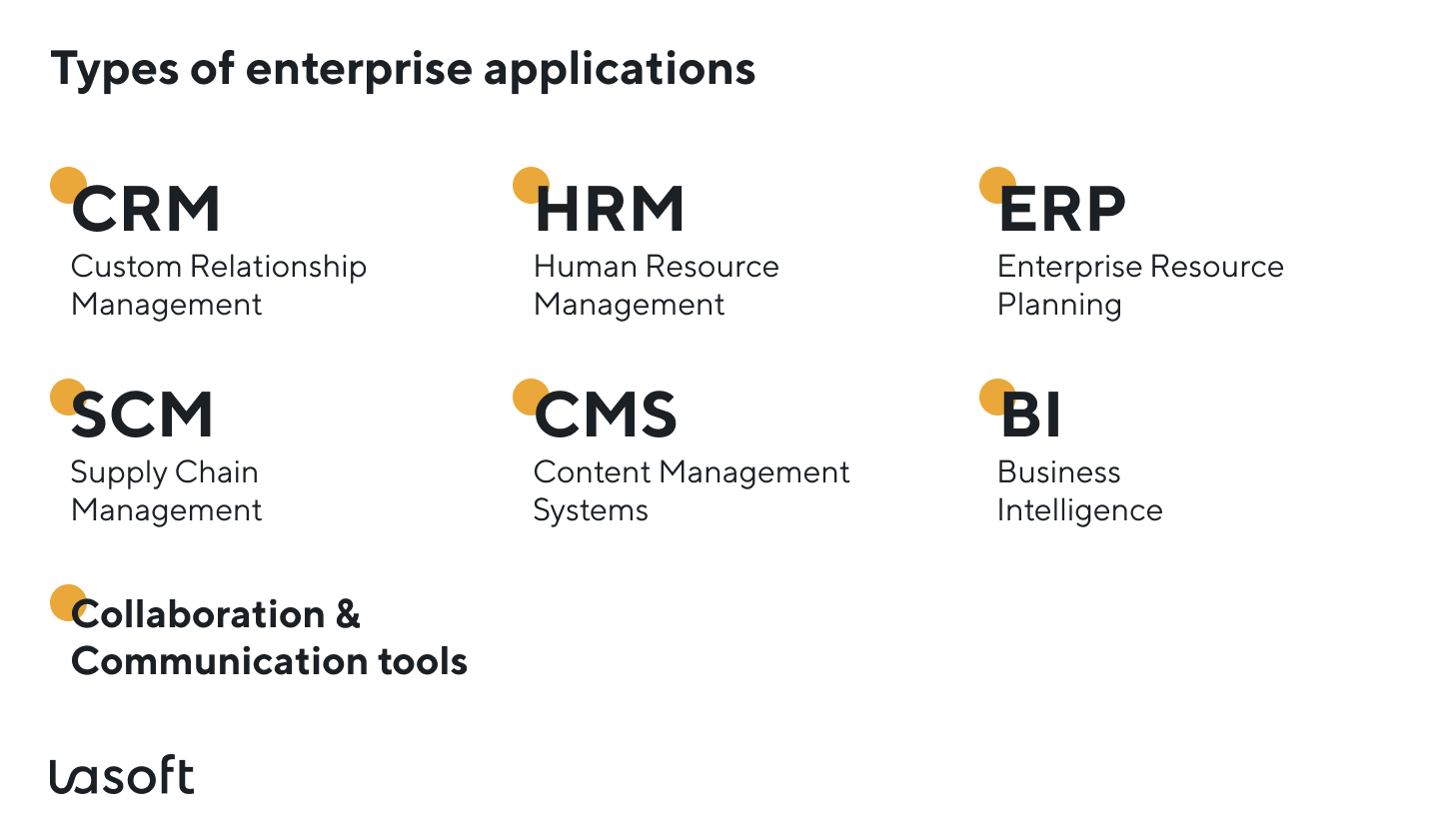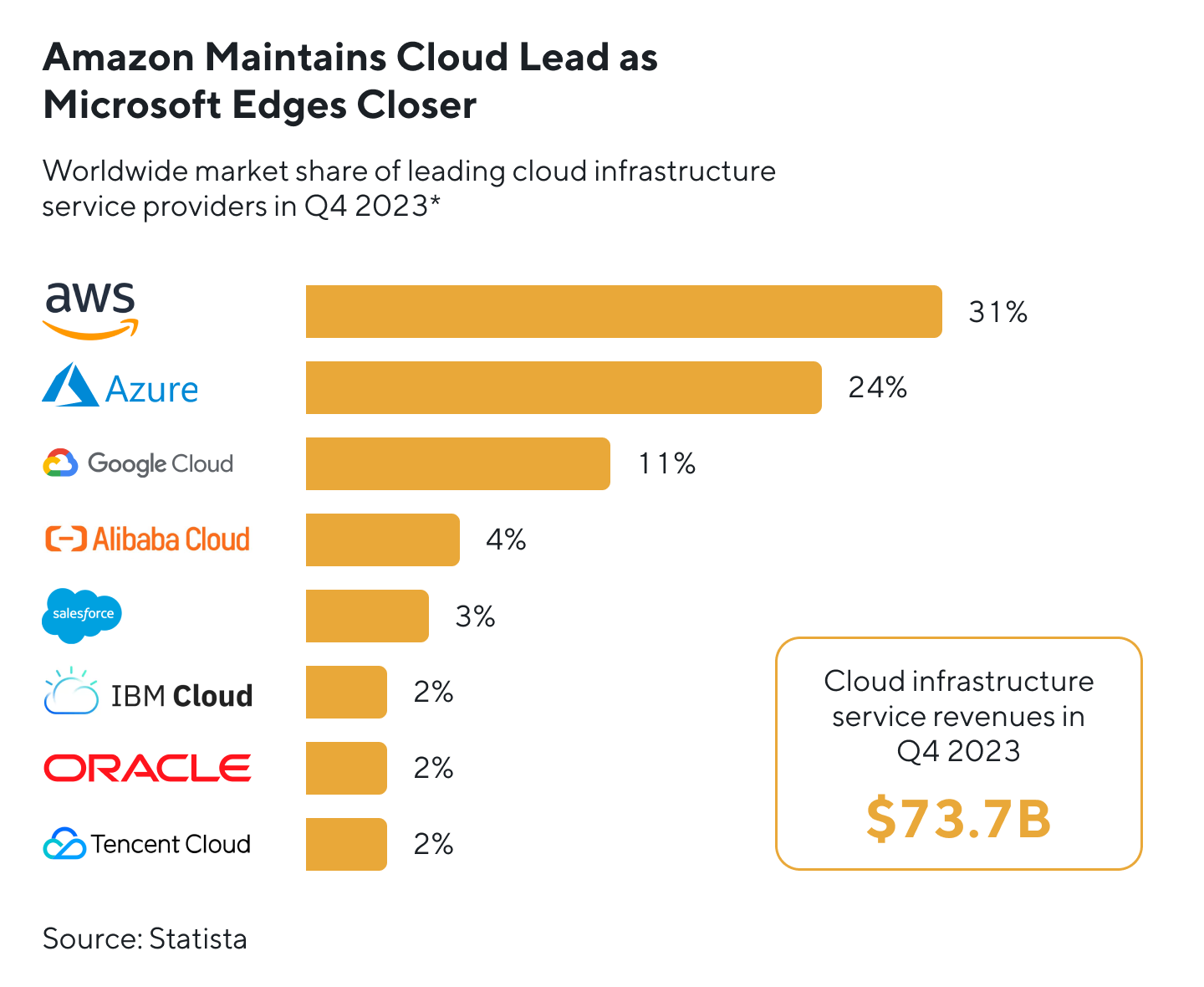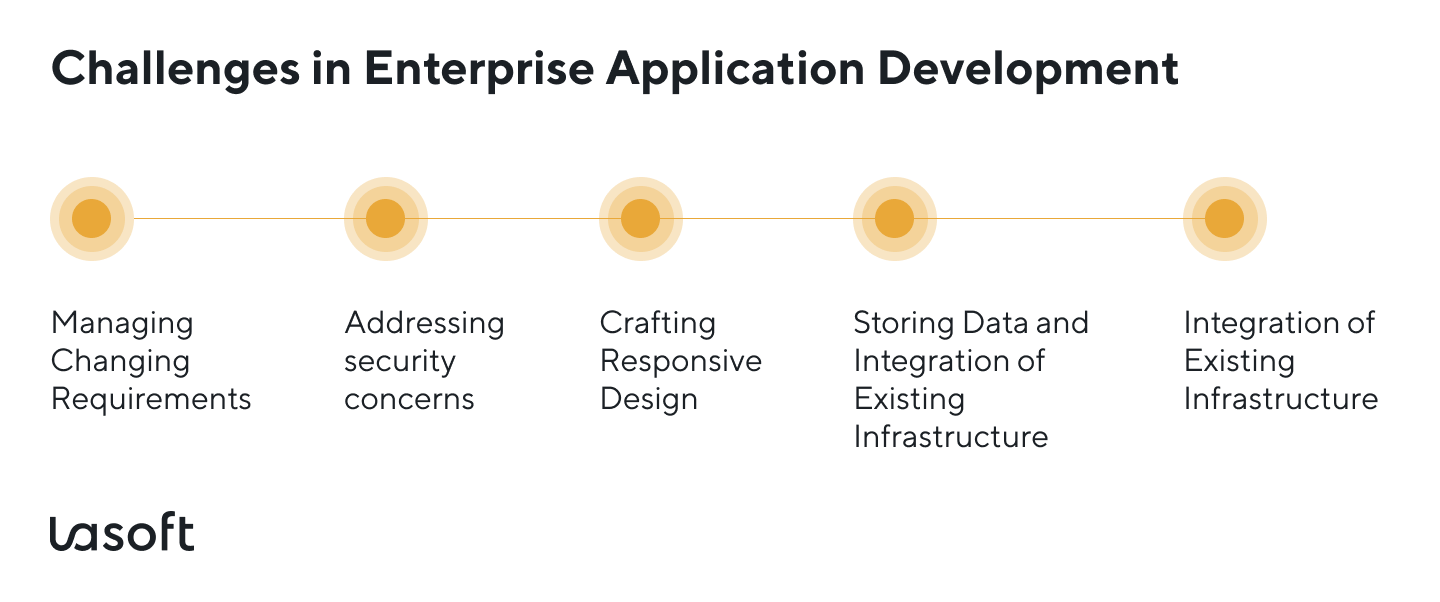Enterprise app development addresses the specific needs of large corporations, to manage complex processes and vast amounts of data effectively.
The enterprise application development process is quite challenging, as teams must manage numerous requirements and objectives while managing expectations from various stakeholders.
To achieve successful outcomes, enterprises must implement a structured development process that maximizes user and business value. Let’s delve into modern development practices, which help enterprises create apps that foster strong connections among customers, employees, and partners, and support future growth.
Enterprise Application Market Size 2022 to 2030, USD billion
- 2024
- 274.63
- 2025
- 293.58
- 2026
- 314.13
- 2027
- 336.44
- 2028
- 360.66
- 2029
- 386.99
- 2030
- 415.63
Source: Precedence research
Understanding Enterprise App Development
Enterprise applications are designed to solve complex business problems, provide employees with access to valuable data, streamline operations, and enhance workflow efficiency. Unlike consumer apps, enterprise applications must integrate seamlessly with existing, so-called legacy systems, handle vast amounts of business data, and comply with security and compliance requirements. So, what are the types of enterprise applications?
Customer Relationship Management (CRM)
CRM applications help us utilize digital strategies and technologies for managing and analyzing customer data and experience throughout the customer lifecycle, during which the client interacts with the product or service. CRM systems compile customer data across different channels, including the company’s website, telephone, live chat, e-mail campaigns, and social media. CRM features empower companies with marketing leverage like contact management, lead tracking, sales forecasting, and customer support management.
Enterprise Resource Planning (ERP)
Enterprise Resource Planning applications integrate various business processes in departments such as HR, finance, and supply chain management. ERP is a platform for managing and automating business tasks and operations. ERP development aims to improve the efficiency of business activity and data accuracy.
Supply Chain Management (SCM)
These applications optimize the flow of goods and automate all processes that transform raw materials into final products. SCM covers everything from product development, sourcing, production, logistics, and the information systems needed to coordinate these activities. Managing operations such as inventory, tracking shipments, and streamlining communication helps facilitate collaboration with suppliers and partners.
Human Resource Management (HRM)
Human resource management (HRM) applications provide many functionalities to facilitate efficient personnel management, including payroll processing, benefits administration, performance reviews, and hiring procedures. HRM guarantees compliance with labor rules and regulations while automating HR processes. The main goal of HRM is to provide optimal human resource management.
Business Intelligence (BI)
BI applications enable the gathering, analysis, and visualization of data to gain insights into business processes. Features often include data integration, reporting, data visualization, and predictive analytics.
The primary purpose of BI is to support management by providing insights derived from data. BI systems offer historical, current, and predictive views into business operations to make informed decisions, optimize processes, and gain competitive advantages.
Collaboration and Communication Tools
Project management tools, document-sharing platforms, and team communication tools facilitate seamless collaboration and communication among team members. They promote teamwork, improve productivity, and enhance information sharing.
Content Management Systems (CMS)
CMS applications help manage and publish digital content, including corporate websites and blogs. They provide web content creation, editing, and publishing tools.

Key Market Trends in Enterprise App Development
The enterprise app development market is rapidly evolving. Key trends, such as mobile enterprise applications, AI and ML integration, cybersecurity and data protection, cloud-based solutions, and IoT integration, are changing businesses that aim to stay competitive and continue growing.
Mobile Enterprise Applications
The proliferation of mobile devices has increased demand for mobile enterprise applications. Internet users can access the web through various devices, including laptops, tablets, and more. However, despite various options, mobile phones remain the most popular choice for internet access. Remarkably, 92.3% of users prefer using a mobile phone over other devices. In comparison, 65.6% of users access the internet via a desktop or traditional laptop. Using the mobile corporate app for business became a vital attribute to provide employees access to essential business functions anytime, anywhere. Mobile enterprise apps enhance productivity, improve communication, and enable real-time data access.
| Device | Share of Users |
| Mobile phone (any) | 92.3% |
| Smartphone | 91% |
| Laptop or desktop (any) | 65.6% |
| Feature phone | 5.2% |
| Tablet device | 27.3% |
| Work laptop or desktop | 28.6% |
| Connected television | 31.9% |
| Smart home device | 15.4% |
Source: Whatsthebigdata
Artificial Intelligence (AI) and Machine Learning (ML)
Integrating AI and ML into your business processes is about staying competitive and transforming your business with innovative software solutions.
AI algorithms analyze user behavior and preferences to deliver personalized content and valuable recommendations, engaging customers effectively. Predictive analytics helps anticipate user needs and actions, while data pattern analyses enable the prediction of what a user might do next, allowing businesses to address their needs proactively. AI ensures that users receive a customer-friendly experience, which can lead to increased engagement and satisfaction. Personalized interactions make customers feel valued and drive brand awareness in the market.
ML transforms enterprise app development by enabling the creation of more innovative applications. ML models analyze historical data to forecast demand, optimize inventory levels, and reduce costs. Accurate demand forecasting ensures your local warehouse has the products in great demand available at all times.
ML algorithms also strengthen data and sensitive information security by detecting and responding to threats in real time. They detect unusual patterns and behaviors that may indicate fraudulent activity. By identifying anomalies in company data that could predict security breaches or other issues, ML solutions enable quick responses to potential threats.
Cloud Computing
Cloud platforms influence how applications are developed, deployed, and managed. CEOs and business owners understand the profound impact of cloud technologies on enterprise app development. Among the numerous cloud providers available, Amazon Web Services (AWS) remains the most popular choice for companies worldwide. AWS offers a comprehensive suite of tools and processes to help businesses’ existing systems transition smoothly to the cloud as part of a digital transformation strategy. Discover LaSoft’s insights on why we recommend AWS migration services and provide these cloud solutions to our customers.
Source: Statista
Internet of Things (IoT) Integration
Software development teams integrate IoT devices with enterprise applications to collect and analyze real-time data, monitor operations, track assets, and optimize processes.
IoT sensors provide insights into equipment performance and maintenance in the manufacturing industry.
In supply chain management, IoT sensors monitor the temperature and humidity, ensuring goods are stored and transported under optimal conditions.
Companies ensure data integrity and privacy by utilizing a vast network of interconnected devices and implementing various security measures, including encryption and authentication.
Continuous monitoring and regular updates help maintain a secure IoT ecosystem, process IoT data to uncover patterns, predict outcomes, and identify areas for improvement.
Challenges in the Enterprise Application Development Process
Developing enterprise applications is a complex task that involves meeting the needs of a large company. Understanding the common challenges in enterprise application development can help software development teams collaborate more effectively and find practical solutions to any difficulties.
Managing Changing Requirements
Managing the changing requirements of the management team and stakeholders is one of the trickiest challenges in enterprise application development. Revising the project scope during development often leads to cost overruns and delayed delivery. To mitigate this, project managers must carefully evaluate and prioritize change requests, ensuring that the development stays within budget and on schedule.
Addressing Security Concerns
Security is a vital concern today, especially when accessing sensitive business information on mobile devices. The risks of data corruption, compromise, and loss are significant. Therefore, it is essential to incorporate multiple-factor authentication and authorization controls when developing an enterprise application. This ensures that only authorized users can access sensitive data, thereby protecting the organization’s information and facilitating advanced threat detection.
Moving to a Mobile Platform
Developers face the daunting task of building user-friendly applications for mobile devices as well as desktops and laptops. Creating responsive designs and ensuring the application functions seamlessly across different devices is necessary for any software development process.
Storing Data and Integration of Existing Infrastructure
It’s challenging for any company to choose the right cloud solution to provide authorized users with efficient and quick access to data or to develop cloud-native apps. The platform should support the scalability and performance needs of the enterprise application and provide reliable data storage and retrieval.
Software developers must choose the right cloud platform and software to integrate smoothly with existing software. Employees prefer to streamline their tools rather than learn new ones. Therefore, it is key to adoption to identify the necessary software and ensure that the new application works seamlessly with it.

Tech Stack for Enterprise Application Development
The technology stack you choose can significantly impact the functionality of your application. Here are some key options to guide you in making the best choice for your enterprise app development:
Native vs. Hybrid App Development
Hybrid App Development: The hybrid app development process involves building an application that operates across multiple platforms using a single codebase. This approach uses web technologies such as HTML, CSS, and JavaScript, which are then wrapped in a native container specific to each platform. Industry statistics indicate that hybrid apps have a shorter development timeframe and, therefore, are more cost-effective. However, they may not match the performance levels of native apps.
Native Apps: Despite the rise of hybrid apps, native app development remains favored for high-performance applications that need deep integration with device features. Designed for platforms like iOS or Android, native apps have become popular among businesses that prioritize optimal performance and a customized user experience.
Data Analysis Tools for Real-Time Informed Business Decisions
For the past few years, new technologies have revolutionized app development. Thanks to their various benefits, they simplify business routine operations for enterprises and help them stay ahead of competitors.
For example, many companies connect IoT devices and sensors, allowing them to collect and exchange data. This connectivity helps gather vast real-time data from diverse sources, including machinery, vehicles, and wearable devices.
AI enhances the capability of enterprise applications to inspire intelligent decisions based on data. By incorporating AI, businesses can automate complex, informed business decision processes, quickly analyze large datasets, and identify patterns humans might miss.
ML, a subset of AI, enables enterprise applications to learn from data and improve their performance over time. ML algorithms can identify trends and patterns, predict future outcomes, and provide recommendations, making enterprise apps more intelligent and adaptive.
Final Insights
Enterprise application development addresses the specific needs of large corporations to manage complex processes and vast amounts of data effectively. Yes, this process is challenging, as it involves balancing numerous requirements and objectives while meeting the expectations of various stakeholders. It’s vital to understand that low-code development platforms can’t offer scalable infrastructure or tailored solutions, which could lead to poor app quality. To achieve successful outcomes, enterprises must implement a structured development process that maximizes user and business value.

FAQ
How Can an Outsourcing Team Help With Enterprise Application Development?
Outsourcing app development service providers offer different options and expertise to businesses aiming to develop functional and enterprise applications. For example, Lasoft’s team can make the most of enterprise application development:
What is the Discovery Stage?
The discovery stage ensures business apps’ success in developing enterprise applications. Our extensive expertise provides comprehensive discovery services to help customers understand their market, users, and competitors.
Our outbound discovery process involves proactively seeking information and collaborating with clients directly at their offices. This hands-on approach allows us to gain valuable insights from both external and internal sources, effectively shaping the direction of the software development project.
How to Develop an Enterprise App: Technical Expertise?
Our app development team of experienced developers crafts customized solutions using proven languages, frameworks, integrations, and infrastructure to bring your vision to life.
We offer expertise and skills to deliver exceptional solutions and results for end users. Companies may cut costs by eliminating specific roles within their teams. However, our experience has shown that omitting even one key role leads to significant losses and quality issues. The entire team becomes more efficient and productive when every role is filled.
What is a dedicated team by LaSoft?
In today’s competitive business environment, a need for more highly skilled talent is becoming increasingly common. Companies worldwide are searching for tech talent, leading many to consider outsourcing some of their projects or processes through a dedicated team model. We organize our development process to consider our clients’ requirements and needs.
Our applications are built with scalability in mind, ensuring that your software can grow in tandem with your business. This approach empowers our developers to seamlessly add new features and capabilities without disrupting your current operations, thereby maximizing the value of your investment.
Our UX/UI designers focus on creating intuitive and user-friendly interfaces. It enhances employee productivity and adoption by making the application easy to use and navigate.
We also use agile methodologies to ensure the development process is flexible and responsive to changes. Regular iterations and feedback loops keep the project on track and aligned with your goals.
We integrate security measures into the architecture to keep your company data and ensure adherence to industry regulations and according to your business needs.


